Last year was one hell of a year for pro and semi-pro photographers. Both Canon and Nikon, which still dominate the pro market, released brand new flagship bodies (1D X, D4), high-megapixel smaller pro bodies (5D Mark III, D800) and entry-level full-frame cameras that are cheaper than anyone ever expected they could be (6D, D600). But now it's 2013, and camera makers at CES are showing that they think many people are tiring of their bulky DSLRs.First, two caveats: DSLRs were very popular in 2012, but because the consumer electronics expo doesn't get too photo-heavy, it's no surprise that manufacturers are skewing their displays towards consumer models. And the top-of-the-line stuff is still around, but only Canon and Nikon (and to a lesser extent, Sony and Pentax) chose to showcase the really expensive stuff. There will be a healthy market for DSLRs for the forseeable future, but compact cameras have taken leaps forward in terms of connectivity and usability, not to mention the fact that across the board digital cameras have never taken better pictures. If CES is an indicator, it looks like the popular cameras of the future will be powered by mobile OSes, more portable, and unlike the ubiquitous DSLR and kit lens combo, more focused and easier to use. Oh, and they'll shoot in 3D.Let's take a spin through what stood out at the show:I headed to Nikon's booth first. (If you're wondering why I've become more interested in smaller cameras, it's because after a day of wandering CES, carrying a D800 and 24-70 starts to feel like a silly bunch of extra weight.) This Coolpix 800c point-and-shoot stood out to me, not only because it embodies how absurd camera specs are these days–16 megapixels, wi-fi connectivity and HD video in a point-and-shoot?–but also because it was rocking the hot new camera accessory: Android. The Android skin used by Nikon has the usual accoutrements of social and web connectivity, but the music player really blew my mind. I have no idea if it's useful (personally, I'd just be using my phone), but when 16 megapixel files are about as big as the average person wants to deal with, I suppose you have to have some new feature to sell.
The Android skin used by Nikon has the usual accoutrements of social and web connectivity, but the music player really blew my mind. I have no idea if it's useful (personally, I'd just be using my phone), but when 16 megapixel files are about as big as the average person wants to deal with, I suppose you have to have some new feature to sell. Panasonic has had a huge part in popularizing the Micro Four-Thirds format, which has allowed for interchangeable lens cameras that are less bulky than DSLRs. Panasonic was pretty much declaring war on DSLRs in its booth, with a video following along a pro street photographer as he took stunning photos with what I believe was Panasonic's GH3, which looks like a mini DSLR but doesn't have the big flipping mirror inside.
Panasonic has had a huge part in popularizing the Micro Four-Thirds format, which has allowed for interchangeable lens cameras that are less bulky than DSLRs. Panasonic was pretty much declaring war on DSLRs in its booth, with a video following along a pro street photographer as he took stunning photos with what I believe was Panasonic's GH3, which looks like a mini DSLR but doesn't have the big flipping mirror inside.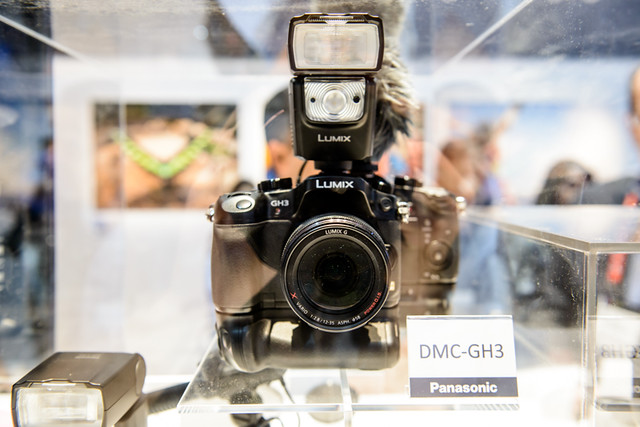 Panasonic also had a display comparing a pair of fully-loaded camera backpacks, one with DSLR gear including a giant zoom, and one with a GH3 load-out, which was much smaller. (It's a bit of an unfair comparison; while a four-thirds camera can use a shorter, smaller lens to get the same reach as a 300mm f/2.8 pro zoom on a full-frame, the 300mm lens is much better glass.) Still, a GH3 with grip and flash is pretty compact, and could make for a cool second camera for when the big stuff isn't necessary.
Panasonic also had a display comparing a pair of fully-loaded camera backpacks, one with DSLR gear including a giant zoom, and one with a GH3 load-out, which was much smaller. (It's a bit of an unfair comparison; while a four-thirds camera can use a shorter, smaller lens to get the same reach as a 300mm f/2.8 pro zoom on a full-frame, the 300mm lens is much better glass.) Still, a GH3 with grip and flash is pretty compact, and could make for a cool second camera for when the big stuff isn't necessary.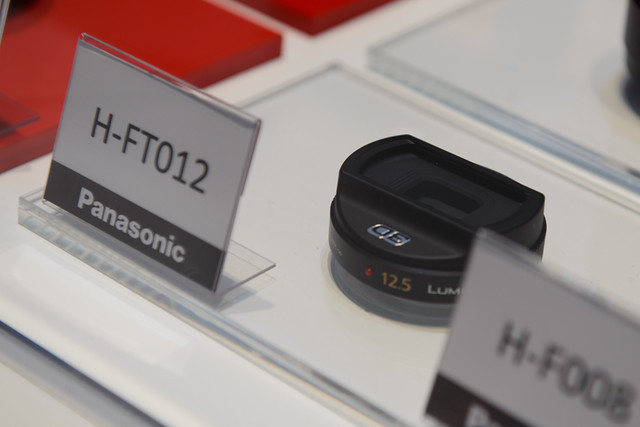 Also cool about Panasonic's system: It features a 3D lens that uses a pair of individual lenses to take 3D/stereoscopic images. The GH3 has been around since June of last year, and is mostly a novelty as the image is really only 3D on 3D TVs. But as we'll see, it welcomed in the 3D trend for still cameras, one that's apparently not going away.
Also cool about Panasonic's system: It features a 3D lens that uses a pair of individual lenses to take 3D/stereoscopic images. The GH3 has been around since June of last year, and is mostly a novelty as the image is really only 3D on 3D TVs. But as we'll see, it welcomed in the 3D trend for still cameras, one that's apparently not going away. Samsung had a pair of cameras on display that were definitely pushing the compact envelope, even if they might not make sense. First up was the Galaxy Camera, which is basically a full-on Android phone that's had the phone part replaced with a point-and-shoot.
Samsung had a pair of cameras on display that were definitely pushing the compact envelope, even if they might not make sense. First up was the Galaxy Camera, which is basically a full-on Android phone that's had the phone part replaced with a point-and-shoot. It can access Google's Play Store to download whatever app your wonderful heart desires. It also featured some pretty slick-looking editing apps built in, which was a theme for most of the Android cameras at the show, and can be enabled to automatically upload photos wherever you want. (Spec-wise, it has a 16.3 megapixel sensor and 21x optical zoom, and takes photos as good as any other higher-end compact. Android feels nice and responsive on the device.) Again, I'm not sure this is something I'd ever use, as I'd rather just have a phone that also had a legit camera, rather than carrying both. It's just too much feature overlap. On the other hand, if it's there, it's hard to say no.
It can access Google's Play Store to download whatever app your wonderful heart desires. It also featured some pretty slick-looking editing apps built in, which was a theme for most of the Android cameras at the show, and can be enabled to automatically upload photos wherever you want. (Spec-wise, it has a 16.3 megapixel sensor and 21x optical zoom, and takes photos as good as any other higher-end compact. Android feels nice and responsive on the device.) Again, I'm not sure this is something I'd ever use, as I'd rather just have a phone that also had a legit camera, rather than carrying both. It's just too much feature overlap. On the other hand, if it's there, it's hard to say no. An even wackier development was this 45mm lens (mounted on a new NX300 APS-C camera) that can actually shoot 3D video with a single lens, unlike the dual lens system used by Panasonic.
An even wackier development was this 45mm lens (mounted on a new NX300 APS-C camera) that can actually shoot 3D video with a single lens, unlike the dual lens system used by Panasonic.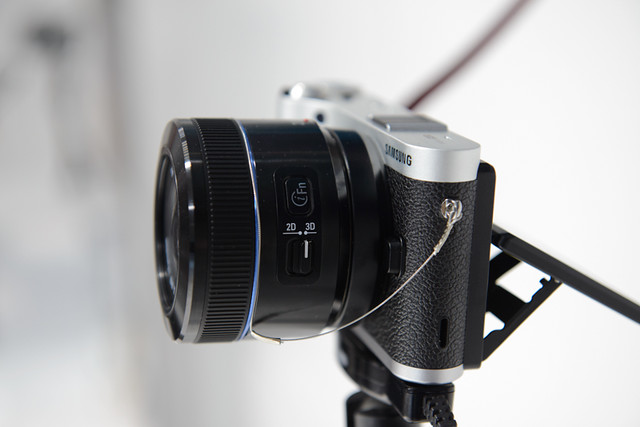 That gives it a 2D option, which adds a nice bit of flexibility. According to the rep I spoke to, it works via a dual-sided shutter system (here's a kinda blurry photo of it) that's similar in principle to how the old shutter glasses for 3D TVs worked. I took it for a test spin on a giant TV, and while the 3D effect worked, it was a little jerky. Still cool to see though.
That gives it a 2D option, which adds a nice bit of flexibility. According to the rep I spoke to, it works via a dual-sided shutter system (here's a kinda blurry photo of it) that's similar in principle to how the old shutter glasses for 3D TVs worked. I took it for a test spin on a giant TV, and while the 3D effect worked, it was a little jerky. Still cool to see though. Now that Kodak's left the film business and Polaroid is doing all kinds of other stuff (more on that in another post), Fuji is the last major film manufacturer left. While the company didn't showcase its traditional film offerings at CES, it did have its instant film cameras on full display. Fuji has two formats of instant film, wide and mini, both of which are traditional emulsion instant films.
Now that Kodak's left the film business and Polaroid is doing all kinds of other stuff (more on that in another post), Fuji is the last major film manufacturer left. While the company didn't showcase its traditional film offerings at CES, it did have its instant film cameras on full display. Fuji has two formats of instant film, wide and mini, both of which are traditional emulsion instant films. More to my taste was Fuji's line of retro-styled camera. I say retro because it's the best way to describe it, but it's wonderful to see the old-school 35mm style make a comeback. The X20 is crazy small, and has a fast 28-112mm (equivalent) f/2-2.8 zoom lens permanently attached. More tech-forward, its new X-Trans 2/3" sensor has some crazy tech that kills moire. That means the camera has no low-pass filter (which adds a small amount of blur at the pixel level to combat moire), so it should produce killer images. If you care, it's 12 megapixels. It's gotten positive reviews, and I personally enjoyed playing with it. It'd make a great walkaround camera.
More to my taste was Fuji's line of retro-styled camera. I say retro because it's the best way to describe it, but it's wonderful to see the old-school 35mm style make a comeback. The X20 is crazy small, and has a fast 28-112mm (equivalent) f/2-2.8 zoom lens permanently attached. More tech-forward, its new X-Trans 2/3" sensor has some crazy tech that kills moire. That means the camera has no low-pass filter (which adds a small amount of blur at the pixel level to combat moire), so it should produce killer images. If you care, it's 12 megapixels. It's gotten positive reviews, and I personally enjoyed playing with it. It'd make a great walkaround camera.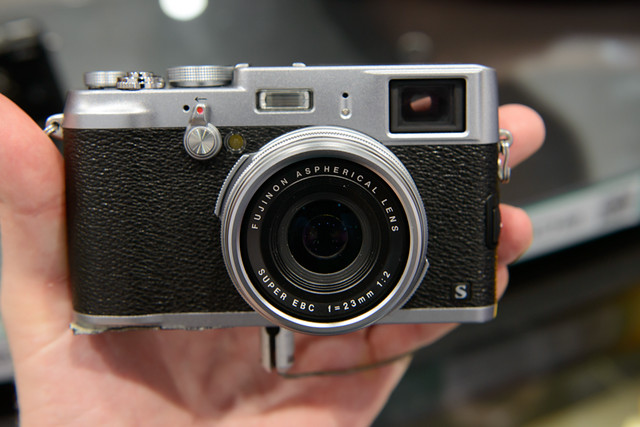 A step up from the X20 is the X100s, which has a larger APS-C sensor with 16.3 million megapixels. It uses the same technology that allows the removal of the low-pass filter, which is a nice step up over the X100 it replaces. It features some nice manual controls, which makes for a really interactive camera.
A step up from the X20 is the X100s, which has a larger APS-C sensor with 16.3 million megapixels. It uses the same technology that allows the removal of the low-pass filter, which is a nice step up over the X100 it replaces. It features some nice manual controls, which makes for a really interactive camera.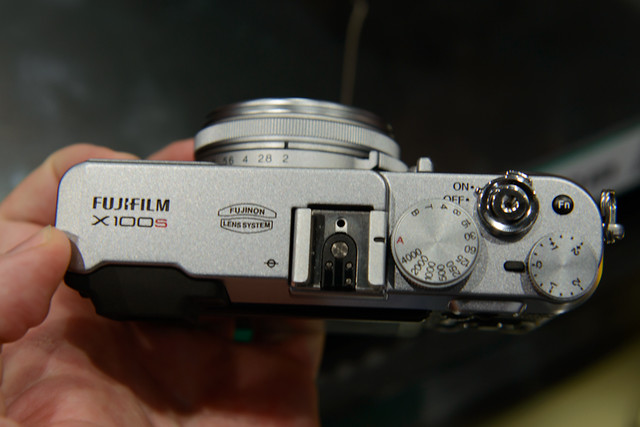 But like the X100, the coolest part about this camera is that it comes with a fixed 35mm f/2 lens permanently attached. Basically, the thing can never zoom, ever, which is awesome. 35mm on that sensor works out to a 50mm equivalent, which is comparable to what your eye sees.
But like the X100, the coolest part about this camera is that it comes with a fixed 35mm f/2 lens permanently attached. Basically, the thing can never zoom, ever, which is awesome. 35mm on that sensor works out to a 50mm equivalent, which is comparable to what your eye sees. And by never zooming, it forces you to think more about what you're shooting, rather than just taking snapshots. I'm a big proponent of shooting with primes (unless we're talking about being lazy at a conference, don't boo me) and the fact that this camera exists is wonderful. If only I could afford one.
And by never zooming, it forces you to think more about what you're shooting, rather than just taking snapshots. I'm a big proponent of shooting with primes (unless we're talking about being lazy at a conference, don't boo me) and the fact that this camera exists is wonderful. If only I could afford one.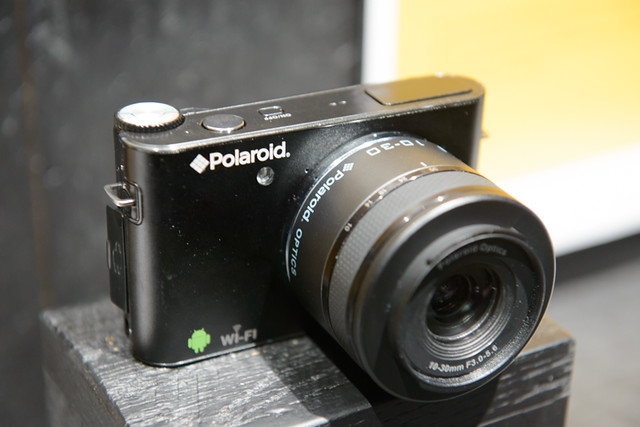 I'm going to write a separate post to talk about Polaroid's exploding product line, but for the purposes of talking about what's next, the company's Android-powered interchangeable-lens camera is a legitimate, if logical, step forward. The only problem is that the pre-production model I played with wasn't very polished.
I'm going to write a separate post to talk about Polaroid's exploding product line, but for the purposes of talking about what's next, the company's Android-powered interchangeable-lens camera is a legitimate, if logical, step forward. The only problem is that the pre-production model I played with wasn't very polished. First off, the most ridiculous part: The camera's sensor is located inside the lens. That makes little sense, means new lenses are either going to be more expensive than usual or have poopy sensors, and means that the lens system is going to be Polaroid-specific. (Why would anyone else try to do make their own version?)
First off, the most ridiculous part: The camera's sensor is located inside the lens. That makes little sense, means new lenses are either going to be more expensive than usual or have poopy sensors, and means that the lens system is going to be Polaroid-specific. (Why would anyone else try to do make their own version?)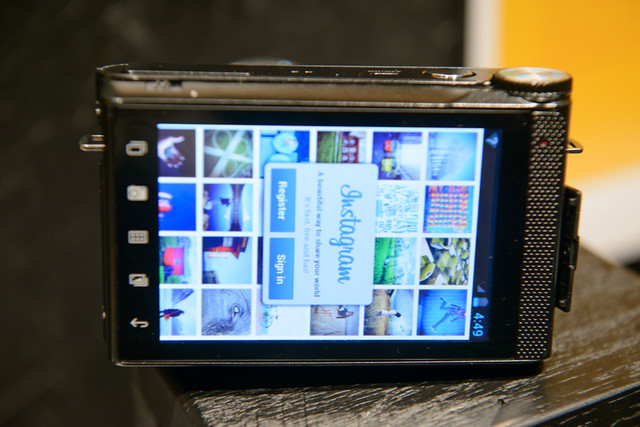 I couldn't test the shooting, as the two devices Polaroid had on hand couldn't take pictures. Pre-production, right? But hey, Instagram and Angry Birds worked.
I couldn't test the shooting, as the two devices Polaroid had on hand couldn't take pictures. Pre-production, right? But hey, Instagram and Angry Birds worked. Canon's Powershot N is the smallest point-and-shoot I've ever seen. It's ridiculously small. So small that it doesn't even have a traditional shutter button; instead, you shoot by pushing the big silver ring with three dots on it, and zoom by twisting the ring behind that back and forth. Those controls are on both the top and bottom of the front of the camera, which means that the Powershot N can work in all kinds of crazy angles.
Canon's Powershot N is the smallest point-and-shoot I've ever seen. It's ridiculously small. So small that it doesn't even have a traditional shutter button; instead, you shoot by pushing the big silver ring with three dots on it, and zoom by twisting the ring behind that back and forth. Those controls are on both the top and bottom of the front of the camera, which means that the Powershot N can work in all kinds of crazy angles. It doesn't have an operating system, but it does have a touchscreen, shoots 1080 video, and has a chill face-tracking feature, as demonstrated here. And did I mention how small it is? I'd love to have a point-and-shoot that's easy to fit in a pocket and take out, because phone cameras still aren't that great. This mini thing could fit the bill.
It doesn't have an operating system, but it does have a touchscreen, shoots 1080 video, and has a chill face-tracking feature, as demonstrated here. And did I mention how small it is? I'd love to have a point-and-shoot that's easy to fit in a pocket and take out, because phone cameras still aren't that great. This mini thing could fit the bill. Sony loves to do its own thing, and the NEX-5R shows that to a T. It came out a few months ago, and while being a kinda awkward looking interchangeable lens camera, it sports some rather impressive specs. But I'm not so concerned with that right now. I'm more interested in the phone's operating system, which is Sony-specific and features apps and an app store. "Apps" in this case are mostly camera features, like editing software and uploading tools. A rep told me that a few of the apps cost money, which isn't crazy, but it is interesting. Android cameras also might see the appearance of photo-specific apps, and already has photo apps that cost coin. But using the app system as a way to sell users more features is fascinating, if a bummer, and may be something we see more of.
Sony loves to do its own thing, and the NEX-5R shows that to a T. It came out a few months ago, and while being a kinda awkward looking interchangeable lens camera, it sports some rather impressive specs. But I'm not so concerned with that right now. I'm more interested in the phone's operating system, which is Sony-specific and features apps and an app store. "Apps" in this case are mostly camera features, like editing software and uploading tools. A rep told me that a few of the apps cost money, which isn't crazy, but it is interesting. Android cameras also might see the appearance of photo-specific apps, and already has photo apps that cost coin. But using the app system as a way to sell users more features is fascinating, if a bummer, and may be something we see more of.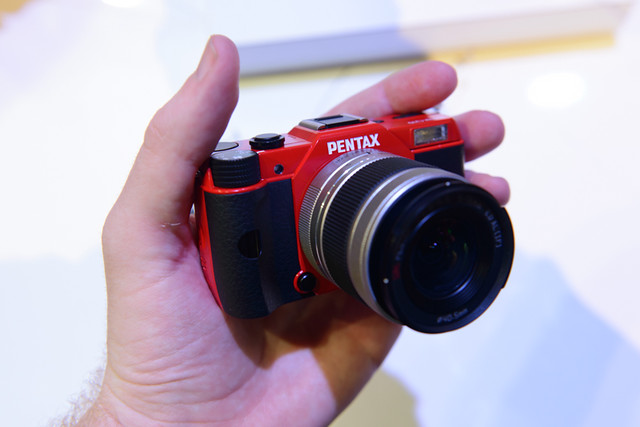 Pentax's Q camera takes the whole "small interchangeable-lens camera" fad to a ridiculous end point. It was the first time I've handled one, and it's legitimately so small that I could barely work it. It's a pretty cool concept, even if tiny sensors don't equate to the kind of image quality you'd want if you're buying a camera system, but why not? This thing is perfect for kids, and no one is going to make one smaller. But sometimes small is just too small.
Pentax's Q camera takes the whole "small interchangeable-lens camera" fad to a ridiculous end point. It was the first time I've handled one, and it's legitimately so small that I could barely work it. It's a pretty cool concept, even if tiny sensors don't equate to the kind of image quality you'd want if you're buying a camera system, but why not? This thing is perfect for kids, and no one is going to make one smaller. But sometimes small is just too small. What I liked more (aside from Pentax's mega-expensive medium-format digital cameras) was the MX-1, which is another retro-ish camera that would feel great to travel or for shooting some street photography.
What I liked more (aside from Pentax's mega-expensive medium-format digital cameras) was the MX-1, which is another retro-ish camera that would feel great to travel or for shooting some street photography. Unlike the X20, the MX-1 has tilting screen, which could be a bonus for you. It also has a smaller-sized 12 megapixel sensor, and as such could be a cool alternative to Fuji's retro offerings.Olympus released a trio of new "tough" cameras and a trio of superzoom compacts. My favorite was the TG-2 (above), which can be dropped from six feet, crushed by 220 pounds, and dragged under 50 feet of water and still survive. I wish all cameras were so badass.That's only a small smattering of the vast quantities of cameras on hand at CES, but I think it's a good sample of where cameras are going. DSLRs are better than ever, but they're also more complicated and, with huge megapixel counts, require more powerful computers, more storage, more everything.Meanwhile, improving sensors and ballooning feature counts–namely connectivity tools–are making compact cameras awesome options for really quick shooting. I mean, at this point, do you really want to lug around a big camera all day and go home to spend a few hours editing photos before uploading them, or do it all seamlessly in a small package? It's not a perfect comparison, as big-ass pro DSLRs are always going to take better photos. But still, it's impressive to even be discussing the trade-offs.
Unlike the X20, the MX-1 has tilting screen, which could be a bonus for you. It also has a smaller-sized 12 megapixel sensor, and as such could be a cool alternative to Fuji's retro offerings.Olympus released a trio of new "tough" cameras and a trio of superzoom compacts. My favorite was the TG-2 (above), which can be dropped from six feet, crushed by 220 pounds, and dragged under 50 feet of water and still survive. I wish all cameras were so badass.That's only a small smattering of the vast quantities of cameras on hand at CES, but I think it's a good sample of where cameras are going. DSLRs are better than ever, but they're also more complicated and, with huge megapixel counts, require more powerful computers, more storage, more everything.Meanwhile, improving sensors and ballooning feature counts–namely connectivity tools–are making compact cameras awesome options for really quick shooting. I mean, at this point, do you really want to lug around a big camera all day and go home to spend a few hours editing photos before uploading them, or do it all seamlessly in a small package? It's not a perfect comparison, as big-ass pro DSLRs are always going to take better photos. But still, it's impressive to even be discussing the trade-offs.
Advertisement
Nikon

Advertisement
Panasonic



Samsung

Advertisement



Fujifilm

Advertisement




Advertisement
Polaroid



Canon


Advertisement
Sony

Pentax


Advertisement
